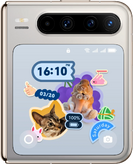Search Foldable Phones
Need a foldable phone? Compare all available or future foldable smartphones, view prices with or without subscription and read user reviews. For those who already want to walk around with tomorrow's phone and are looking for The Next Big Thing, this is the starting point of your search. Read more
Foldable mobile phones are phones that can usually be folded in two. Usually this also applies to the screen, so you can still put a large screen in a small housing.
High grail
Foldable phones are seen as a holy grail in the quest to put ever larger screens into ever smaller enclosures. By folding a screen, you roughly halve its size with the only drawback being increasing thickness.
Foldable makes a lot possible
This design is relatively new and may be at the cradle of many new designs. There are many ways in which phones can be folded in two. Horizontally as a book or vertically as a notepad. A manufacturer may also choose to unfold only part of the appliance. Even before the first foldable phones came out we saw many different designs. Fact is that it inspires a lot of manufacturers to come up with something new again.
False start
Anyone who says foldable phone immediately thinks of the Galaxy Fold; Samsung's first foldable phone. The company gave some tech-journalists and YouTubers a test sample just before its worldwide launch. Some of them broke down after just a few days. Samsung postponed the launch to solve any problems and save the future of foldable. Foldable is seen as the next chapter in the still relatively short history of smartphones.
Foldable: flexible screens
Manufacturers have been fantasizing about fully foldable phones for years. A forerunner of this were phones with flexible screens, think of the Samsung Galaxy Round. It had a spherical screen. Others also made the housing partly flexible, such as LG with the LG Flex.
Yet it was mainly Samsung that did a lot of research into flexible screens and associated housings under the name Youm. After the Round we saw the AMOLED screens mainly under the name Edge with its characteristic sloping edges. Phones that were equipped with this were not flexible themselves and did not have a real killer function on the rounded screen either.













